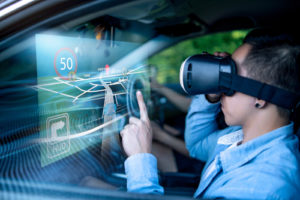To be competitive in the workplace, you need more than a degree. As students and job seekers look to highlight their soft skills and life experience, educators and employers still struggle to evaluate these sought-after qualifications. A new type of assessment could help.
Immersive simulations are an innovative approach to evaluation. These types of assessments allow people to apply what they’ve learned rather than simply recalling answers. Through simulations, students can show their knowledge and abilities. When compared to past methods of assessment like multiple-choice tests, group projects, writing a paper, or role-play exercises, immersive simulations are a more authentic assessment of complex skills.
Playing an active role in a professional scenario is also far more engaging than regurgitating facts. And simulations can be scored through automation, saving educators time and reducing bias.
The potential for immersive simulations is boundless, but two implementations have the most immediate promise.
Assessing microcredentials
One way immersive simulations can be adopted is for the assessment of skills that help students earn microcredentials. Microcredentials provide a way for students to develop discrete abilities and, importantly, offer potential employers proof of those skills. Historically, students could learn and practice 21st-century skills such as empathy, critical thinking, and initiative, but there has been no validated market signal to demonstrate competency. That’s changing now.
Immersive simulations, like the ones that assess a set of 21st Century Skills that Education Design Lab has created, are solving the challenge.
Before this sort of microcredentialing existed, educators had to rely on time-consuming manual assessments, while employers could only make hiring choices based on information from resumes or references. Immersive simulations, by contrast, provide an automated, unbiased way for students to demonstrate their learned skills. For example, students who want to earn a critical thinking microcredential can complete an assessment that dives deep into their skill performance. Through a simulation, students answer a series of questions that evaluate the various aspects of critical thinking. At the end of the assessments, facilitators, educators, and employers can see a dashboard that displays which answers a student got right and which they got wrong. The dashboard makes it easy to see the full evaluation of students’ skills, as well as where the student excels and where they have deficits.
Credit for experience
Immersive simulations can also solve the conundrum of how we assign standard value to experience and transferable skills. As employers seek ways to diversify their teams, this could be invaluable. A uniform way to evaluate candidates who have experience in different industries or skills that are earned outside of an education credential could quickly open doors to veterans as well as people who are unemployed or underemployed.
One model educators can follow is the XCredit project. The project designed a way to provide credit for experiences that individuals have acquired informally. By introducing immersive simulations, XCredit gives individuals the opportunity to showcase what they know and can do in ways not seen in grades, a resume, or even a job interview.
For example, job seekers can demonstrate their active listening skills by participating in an immersive simulation in which they gather client feedback after an event. The XCredit project is developing a set of these performance-based assessments and digital credentials for 21st century skills and their corresponding sub-competencies, which employers are looking for in new hires.
Simulations are the future
Students will continue to seek out ways to develop the skills employers want, in ways that embrace speed and choice. As educators fulfill this new market demand through unbundled certifications, they must complement these microcredentials with new methods of assessment. Next-generation assessments like immersive simulations will empower individuals to showcase what they know and can do. Adopting these assessments will seed a larger, more diverse hiring pool and ensure more students have the opportunity to contribute to a growing economy.
- A bungled FAFSA rollout threatens students’ college ambitions - April 19, 2024
- Using real-world tools to prepare students for the workforce - April 18, 2024
- 8 top trends in higher education to watch in 2024 - April 16, 2024

